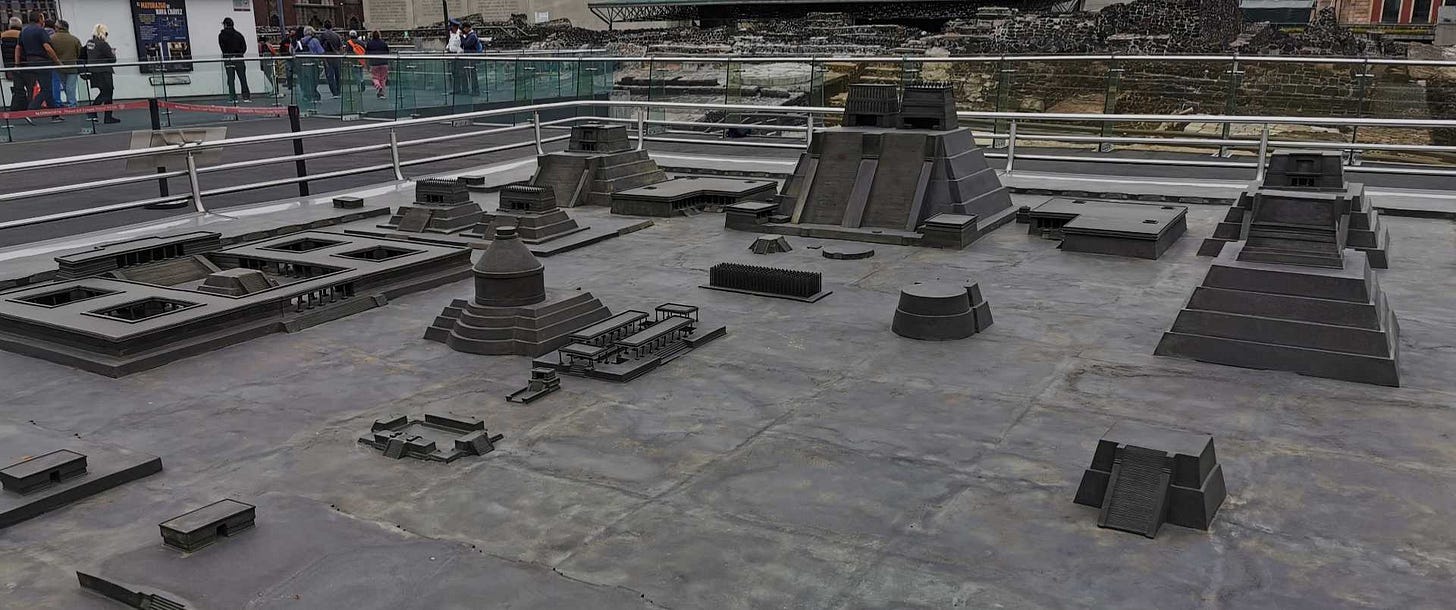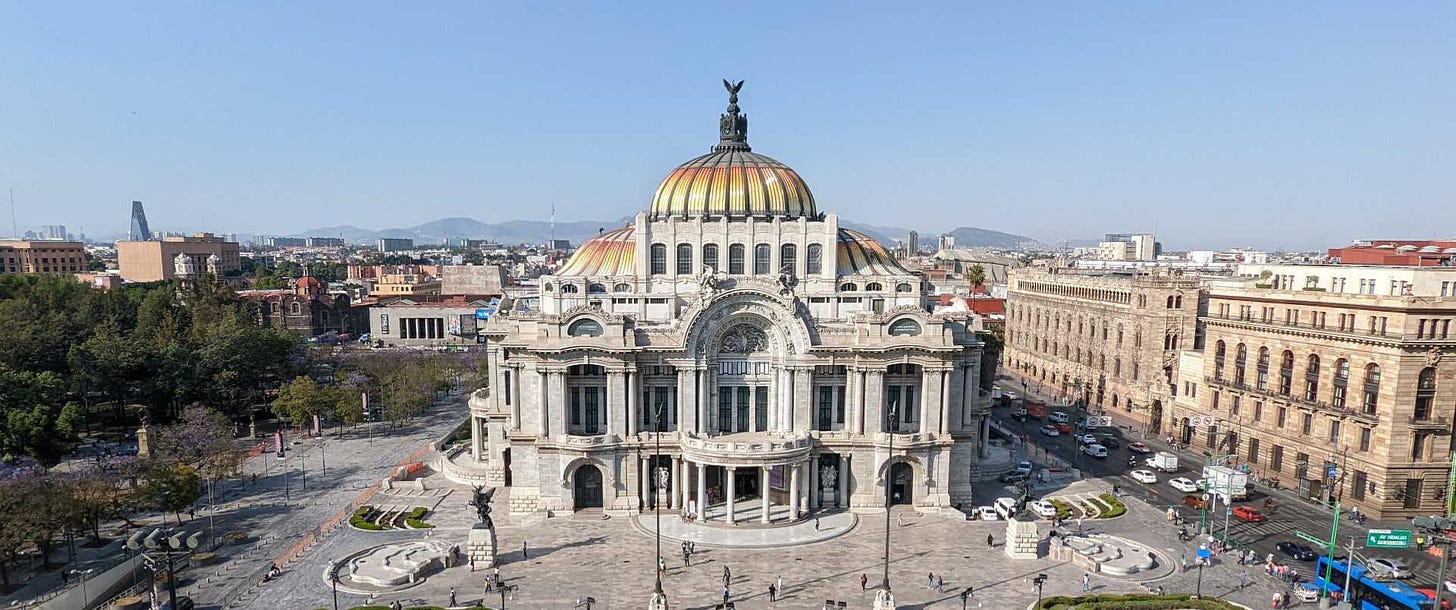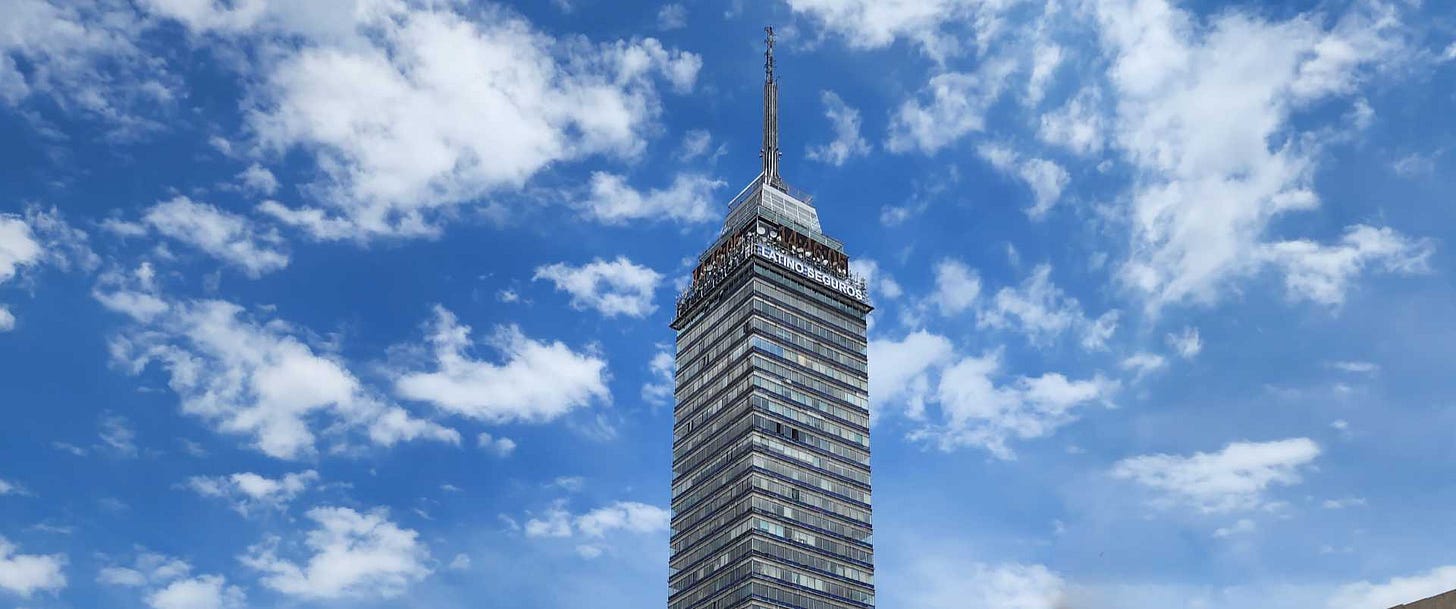Mexico City: Top sights in and around Centro Histórico
Centro Histórico in Mexico City is a top center for history and culture. Here are our favorite things to see and do in this vibrant district
Mexico City’s Centro Histórico is the ideal place to start your visit to the city. You’ll find some of the city’s top sights in this vibrant, walkable area, as well as restaurants, cafes, and bars to stop in when you need a bite to eat or a break from sightseeing. Here are some of the parks, plazas, palaces, and more you’ll find in the historic center.
—
This is an excerpt from our upcoming book, Eternal Spring: Our Guide to Mexico City.
Key:
🌳 Park or outdoor place
🏛️ Monument or other important sight
🚶 Walk or notable street
🎾 Arena or other sports venue
🎨 Museum
👁️ Something to see
🛍️ Shopping
—
🌳Alameda Central
Alameda Central opened in 1592 and though it's the oldest public park in the Americas, it's still a lively oasis of green and one of our favorite spots in the city. It's a pretty space crisscrossed by paths whose design dates back to the 18th century, with several fountains that fill up with children and dogs on hot days, and two impressive monuments, the Monumento a Beethoven in the park's east and the larger Benito Juárez Hemicyclein monument at its middle south.
Don't avoid Alameda Central if it's dark: The park is safe day and night. It's a great place to stroll, people watch, and enjoy street performers, and it's especially fun at night, when impromptu all-ages dances break out at its major path intersections. The park is next to the incredible 🏛️ Palacio de las Bellas Artes, directly to its west.
Be sure to check out the pretty Parisian Art Nouveau entrance to the Bellas Artes Metro station between Alameda Central and Bellas Artes: It was gifted to Mexico City by French President Jacques Chirac in 1998.
🚶Avenida Francisco I. Madero
This pedestrian-only avenue runs for less than a half-mile and takes you from the southeast corner of the grounds in front of 🏛️ Palacio de Bellas Artes to the 👁️ Plaza de la Constitución (Zócalo).
It's lined with shops and sights, including the 👁️ Torre Latinoamericana and the 👁️ Casa de los Azulejos. The avenue is often busy, with musicians and street performers entertaining families, shoppers, and tourists strolling along the route.
Avenida Francisco I. Madero is also the ideal place to see—and hear—Mexico City organilleros (organ grinders). They work in pairs, with one grinding away on an off-key organ and the other working the crowd for tips. Be sure to give them one, especially if you take a photo or make a video of this curious Mexico City institution.
👁️Biblioteca de México
This magnificent library is an oasis for Spanish language writers and readers, with free indoor and outdoor spaces to create, research, and relax. But it's also a pretty photo op for visitors who find themselves in the area, and a nice change of pace from nearby 🛍️ Mercado de Artesanias la Ciudadela.
👁️Casa de los Azulejos
At Avenida Francisco I. Madero 4, you'll find the Casa de los Azulejos (House of Tiles), an ornate 18th-century palace covered by blue and white tiles with a dramatic facade. It's reminiscent of the blue tiles common in Lisbon, Portugal.
Take a moment to step inside and take in the elegant interior courtyard behind the gift shops. It's lined with mosaics and murals and hosts a Sanborn's restaurant, so you can stick around for a drink or a meal and admire the surroundings.
🏛️Catedral Metropolitana y 🏛️Sagrario Metropolitano
Recognized as a UNESCO World Heritage Site for its architecture, the ornate Roman Catholic Catedral Metropolitana de la Ciudad de México (Mexico City Metropolitan Cathedral) is the oldest and largest cathedral in Latin America. Construction began in 1573, soon after the Spanish conquered the Aztecs. It's built on the site of a former Aztec temple, to the north of the 👁️ Plaza de la Constitución (Zócalo).
The Cathedral is impressive inside and out. And you can optionally tour a bell tower, which gives you views of the Zócalo and the city.
Don't miss the Parroquia de la Asunción Sagrario Metropolitano (Metropolitan Sanctuary) next door. This is a smaller, red-bricked church that was built in the mid-1700s and serves as a parish. It's not as awe-inspiring as the main cathedral, but it's full of quirky artifacts and other curiosities, and is worth a look.
👁️Gran Hotel Ciudad de Mexico ⭐️
Just off the southwest corner of the 👁️ Zócalo at 16 de Septiembre 82 is the Gran Hotel Ciudad de Mexico, which you can see featured prominently in the opening scenes of the James Bond movie Spectre.
As you enter the hotel, look up to see its striking Art Nouveau-style stained-glass ceiling. After staring in wonder and taking some photos, make your way to the check-in stand by the elevator to see whether you can go up to 🍴 La Terraza Gran Hotel to enjoy a meal or a drink with stunning views of the Zócalo.
🛍️Mercado de Artesanias la Ciudadela
Vendors at this artisanal market sell a range of souvenirs that are a step above the straw sombreros and Frida Kahlo tote bags you'll find at the tackier stands. Shop here for jewelry, folk art, blankets and textiles, toys, wall hangings, pottery, and more. We certainly do: We've purchased a few items for our apartment here, and more than a few gifts.
There's also a small, casual restaurant inside the market if you want to take a break with a drink or a meal.
Across the street to the south, at the Parque de la Ciudadela, you'll often find more vendors selling an assortment of items, more like a flea market than an artisanal market. The park is peaceful and worth a stroll as well.
🛍️Mercado Lagunilla Ropa y Telas
This vast clothing and fabric market with more than 1,000 vendors is located about a 20-minute walk or Metro ride north from the Zócalo.
Throngs of people come for its costumes, vintage clothing, formal apparel, quinceañera dresses, and traditional embroidered dresses and mariachi-style suits. But it's worth seeing just for the spectacle on display.
🛍️Mercado de San Juan Pugibet
The San Juan Market is renowned for its gourmet and exotic foods. Don't be surprised to find ants, worms, and grasshoppers for sale (as food), as well as meats like crocodile, ostrich, and possibly even lion.
If you have a more mainstream palate, look for fruits, vegetables, fresh fish, imported meats and cheeses, or stop at one of the stalls selling meals, juices, and pastry. There are several good restaurants to choose from.
🏛️Monumento a la Revolución
The Monumento a la Revolución (Monument to the Mexican Revolution) was designed and built over time, so its architecture is a mix of Art Deco and Mexican Socialist Realism on top of a Neo-classical cupola.
You can take a panoramic elevator up into the monument and then walk the rest of the way to the top and enjoy the city views. Doing so requires a bit of effort, thanks to the cramped indoor/outdoor spaces you traverse. We don't recommend doing this on a rainy day, as the metal stairs and other surfaces get slippery.
Underneath the monument, you'll find the Museo Nacional de la Revolución (National Museum of the Revolution). It's centered around the events leading up to the Mexican Revolution and also hosts exhibitions related to the revolution and to non-violence.
🎨Museo del Templo Mayor
Located behind the 🏛️ Catedral Metropolitana y Sagrario Metropolitano and next to 👁️ Plaza Manuel Gamio, the Museo del Templo Mayor y Zona Arqueológica (Templo Mayor museum and archeological site) houses more than 3,000 artifacts from the ancient city of Tenochtitlan, the pre-Hispanic center of politics and religion. The site was destroyed in the early 1500s and wasn't rediscovered until the beginning of the 20th century.
If that's too much for you, be sure to at least check out the free, ground-level models that depict what this area of the city looked like at various points in history.
🏛️Palacio de Bellas Artes ⭐️
The Palacio de Bellas Artes—or just Bellas Artes—is probably the most beautiful and iconic building in all of Mexico City. Its design is mainly Art Nouveau on the outside, with a white carrera marble façade, sculptures in the entrance and the plaza, and a striking golden dome on the roof.
The Art Deco-style interior showcases enormous murals by Diego Rivera and other prominent artists, and there are smaller exhibition rooms, some with temporary exhibits, plus a theater that hosts live shows.
The curtain in the theater was made by Tiffany's and consists of almost a million pieces of iridescent glass. You can see traditional dance performed by the Ballet Folklórico de México here, which is a nice way to appreciate the culture in a way you can understand even if you don't speak Spanish.
For the best possible photos of the building, enter the Sears department store across the street—yes, Sears—and take the escalators up to the ☕ Finca Don Porfirio coffee shop and its outdoor terrace on the 8th floor. That's where we took the photo you see above.
🏛️Palacio Nacional
The Palacio Nacional (National Palace), found alongside the entire east side of the Zócalo, is the center for Mexico's federal government and the home of the president.
The main balcony in the center of the palace is where the president of Mexico rings the bell and leads the chant to recognize Mexico's independence every September 15.
The interior displays murals painted by Diego Rivera, but it's closed to the public at the time of this writing. It may be possible to get inside as part of a group tour.
Once it fully reopens, you'll need your passport to enter the National Palace. Tickets are available across the street to the north. And you should get those tickets early in the day, as your entry time will likely be hours later. We've struck out trying to get tickets repeatedly.
🏛️Palacio Postal ⭐️
The Palacio Postal (Postal Palace) may be the most beautiful post office anywhere in the world. It was built in a mix of architectural styles and opened in 1907 as a main post office. It's still in use.
Inside, it's full of elaborate details and decor, including gargoyles and marble staircases. You could see it all—and take dozens of photos—in just a few minutes. But there's also a museum where you can view historical postal tools and documents, and it's worth seeing too.
👁️Plaza de la Constitución (El Zócalo) ⭐️
The Plaza de la Constitución is more commonly known as the Zócalo, and it was originally the center of Tenochtitlan, the ancient city conquered by the Spanish. It's now the central plaza of Mexico City and the political and religious center of all of Mexico.
Your experience here will vary wildly depending on when you go. The plaza is sometimes empty save for people. But it often hosts fairs, festivals, concerts, exhibits, and key events like the celebration of Mexico's independence (September 15) and Dia de los Muertos (November 2). During these times, the plaza is much, much busier and can even be a bit daunting. Gird yourself for the crowds.
In the center of the plaza is an enormous Mexican flag that's raised and lowered every day. Flanking the plaza are the 🏛️ Catedral Metropolitana, 🏛️ Palacio Nacional, other government buildings, and shops. There are also a few restaurants—including two we recommend, 🍴 Primer Cuadro and 🍴 Terraza Gran Hotel—with beautiful views of the plaza, day and night. Try to time a visit to sunset so you can see (and photograph) Zócalo in the changing light.
👁️Plaza Garibaldi
A few blocks north of 🏛️ Palacio de Bellas Artes, you'll find Plaza Garibaldi, a center for mariachi music. You can listen to bands here and hire them for parties and events. The area is designated as a Barrio Mágico (magical neighborhood), and it's a popular nightspot.
👁️Plaza Manuel Gamio
This small plaza is next to the 🏛️ Catedral Metropolitana and adjacent to the 👁️ Zócalo, but you can just as easily find it by following the smell of incense. Traditional dancers in indigenous dress perform here for tourists, and they expect a small donation if you take photos or videos. For a slightly bigger donation, they will pose with you or perform a blessing.
👁️Plaza de Santo Domingo
The Plaza de Santo Domingo is a pretty and much smaller plaza to the northwest of the 👁️ Zócalo. It's considered the home of Cuauhtémoc, the last Aztec emperor. Today, it's the site of the Santo Domingo Temple, and while there are often market stalls and street performers, we find it a pleasant place to relax and do some people watching in a calmer environment than the Zócalo.
For an even better view, check out the 🍴 terrace restaurant atop the Domingo Santo Hotel. It's a great place to grab a drink, or brunch or any other meal.
👁️Plaza de la Solidaridad
To the west of 🌳 Alameda Central is the Plaza de la Solidaridad, built on the site where the Hotel Regis collapsed in the 1985 earthquake.
If it's empty when you visit, you will easily find the iconic statue commemorating the victims and heroes of the 1985 Mexico City earthquake. But on Thursdays through Sundays, the plaza fills with a market with street food, aguas frescas (flavored water), and vendors selling all kinds of merchandise and inexpensive souvenirs.
There are often book fairs and other seasonal events alongside the plaza, too, on the border with Alameda Central.
👁️Torre Latinoamericana ⭐️
The Torre Latinoamericana (Latin American Tower) was the tallest building in Latin America at the time of its completion in 1956. And while many of the newer skyscrapers straddling the 🚶 Avenida Paseo de la Reforma and elsewhere in Mexico City are taller, the Torre is unique in Centro and is easily seen from many vantage points in the area.
From the outside, the tower looks old and even beat-up—it reminds us of a shabbier version of the Prudential Tower in Boston—but that's by design: As a historical monument, its owners are unable to alter the exterior of the building. It's perhaps most famous for having withstood numerous earthquakes without sustaining any damage.
Be sure to go inside and buy tickets for the Mirador Torre Latino, an observation deck on the tower's 44th floor that offers panoramic views of Mexico City in all directions. It's correctly billed as the best view of the city, and it's worth experiencing day and night, if possible.
We’d love to get your feedback as we build out our guidebook. Please ❤️ if you like what you see here or 💬 with any thoughts or suggestions.
Centro Histórico restaurants
You'll find some of Mexico City's oldest and most iconic restaurants in Centro Histórico. From classic dining spots to stunning views, we think these are worth a visit:














Very well written. I stayed at the gran hotel de la ciúdad recently. The restaurant at the top is really great. Have been enjoying your YouTube videos.
I haven't been to Mexico yet, and I'm saving these along with the googlemap pins, thank you!